There are lots of reasons why companies decide to rebrand, and they’re almost always wrong.
Case in point: news broke this week about the iconic Americana-themed restaurant chain Cracker Barrel’s “woke” rebrand. Condemnation has been swift, brutal, and spot-on.
Let it forever be known
Cracker Barrel CEO Julie Masino and CMO Sarah Moore have destroyed their careers
They spit in their customers faces and tore down decades of brand loyalty b/c they wanted to be woke girl bosses
They now join former Bud Light marketing idiot Alissa… pic.twitter.com/hnyDLduzr6
— DC_Draino (@DC_Draino) August 22, 2025
I choose the original flavor, not the extra wokey pic.twitter.com/XQlZ5pnZf6
— AmericanRebel (@AmericanRebble) August 21, 2025
Hi, I’m here to destroy an iconic brand in record time. pic.twitter.com/Cw2xmCkp3q
— Catturd ™ (@catturd2) August 21, 2025
Cracker Barrel is not something you modernize. That’s the whole damn point of Cracker Barrel.
— Stoic Patriot (@StoicPatriot76) August 21, 2025
Cracker Barrel stock tumbled on the announcement, wiping out $90 million of value in a single day. That’s just the beginning of what’s likely more to come — not to mention the $700 million they’re spending on the rebranding effort itself.
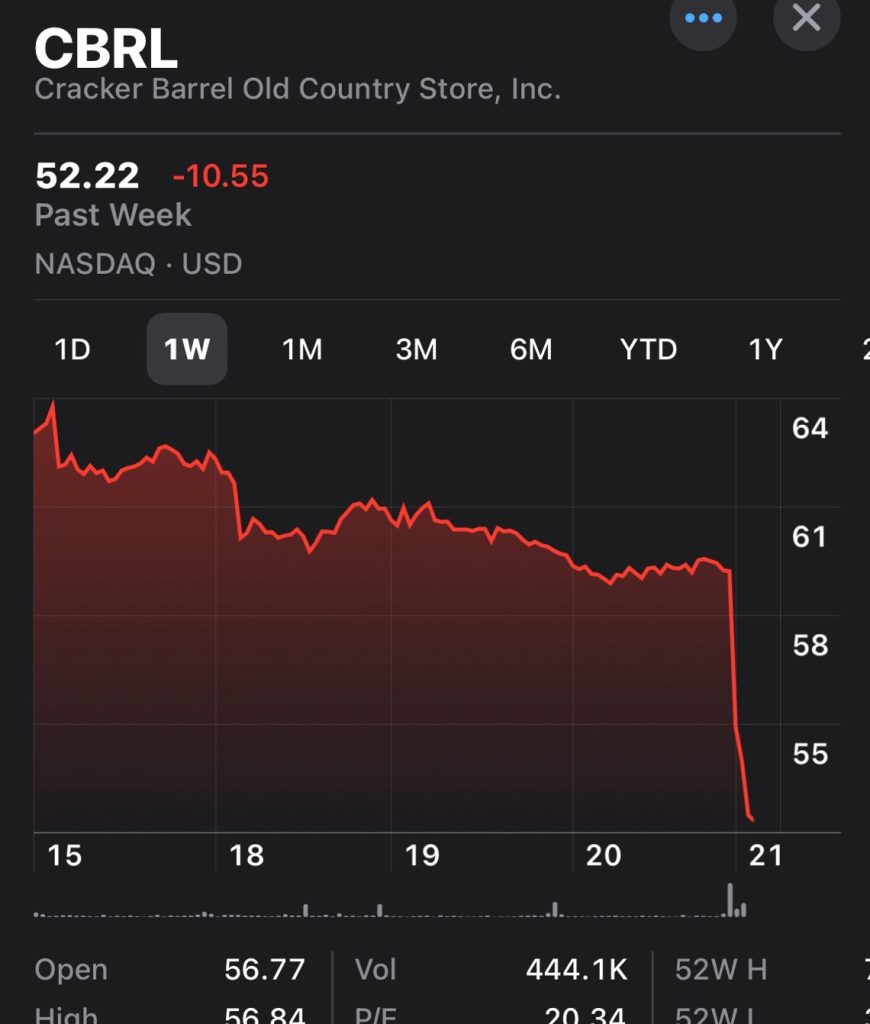
Cracker Barrel execs apparently feel company growth is not what it should be, and they may certainly have a point, although I would argue that’s part of the overall industry trend right now. This is not a good time for the Restaurant business, period. However, there are so many other things one could do to make improvements, a rebrand should be approximately LAST on the list. And even if it really was rebrand-time, the LAST thing you want to do is destroy the reason customers frequent your business in the first place!
From small business owners to corporate executives, even when their intentions are good, and the reasons why they’re led to pull the “let’s rebrand!” trigger are very understandable, it’s almost always the wrong decision. It’s the thing business people do when they are inexperienced, don’t know what else to do, or when a slick marketing agency manages to sell them on the “necessity” of it. The are other reasons too, but the outcomes are often the same: they range from just plain stupid and needlessly expensive, to downright bad and disastrous.
That’s not to say ALL rebrands are bad — sometimes, under very specific and limited circumstances, a rebrand might be the right way to go. But so often I see rebranding applied as the first option when it’s just plain the wrong move to make.
I’ll go over the reasons when it’s right to rebrand later on. But first, let’s look at when rebranding is wrong:
What’s wrong with the Cracker Barrel rebrand?
If you don’t know what Cracker Barrel is, it’s American comfort food. It’s like going to Grandma’s house for dinner. It’s a piece of Americana. See for yourself:
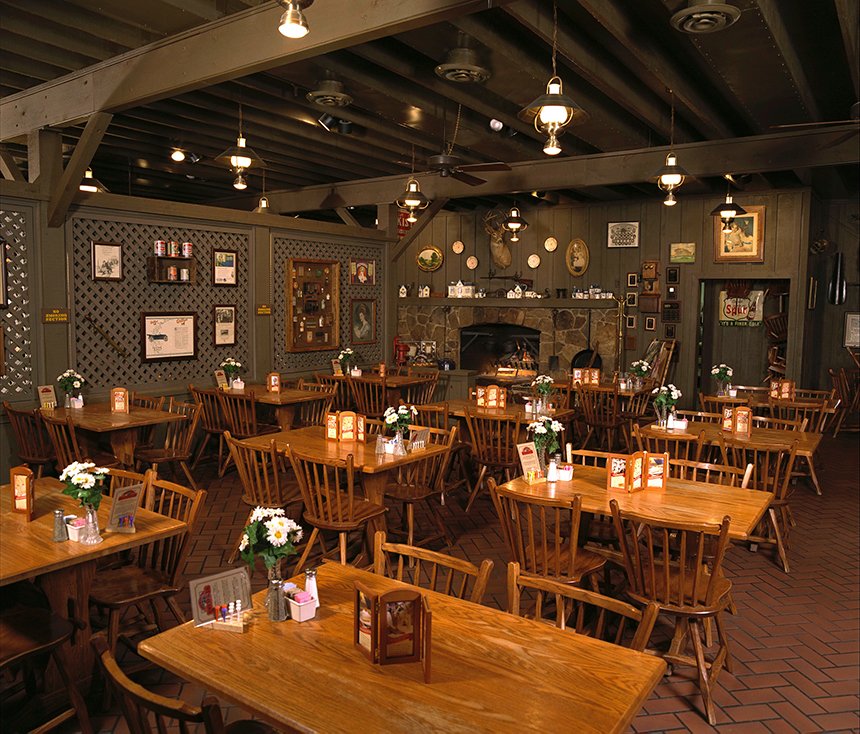
The colors are subdued, the lighting is warm. The wooden tables, the kitsch-y shit on the walls — it’s all somehow comforting on a deep psychological level. Well, at least for me it is. My grandmother was from the Midwest, she loved to cook, and she had a wood table (albeit round) and chairs exactly like that. So maybe I’m pre-programmed to find this environment comforting. Certainly not everyone has had the same experience or would feel the same way, but then again, considering how busy the Cracker Barrel by my house always is, clearly I’m not alone.
So if, as a business, that’s your “thing” and it’s the reason people know you, why would you do this:
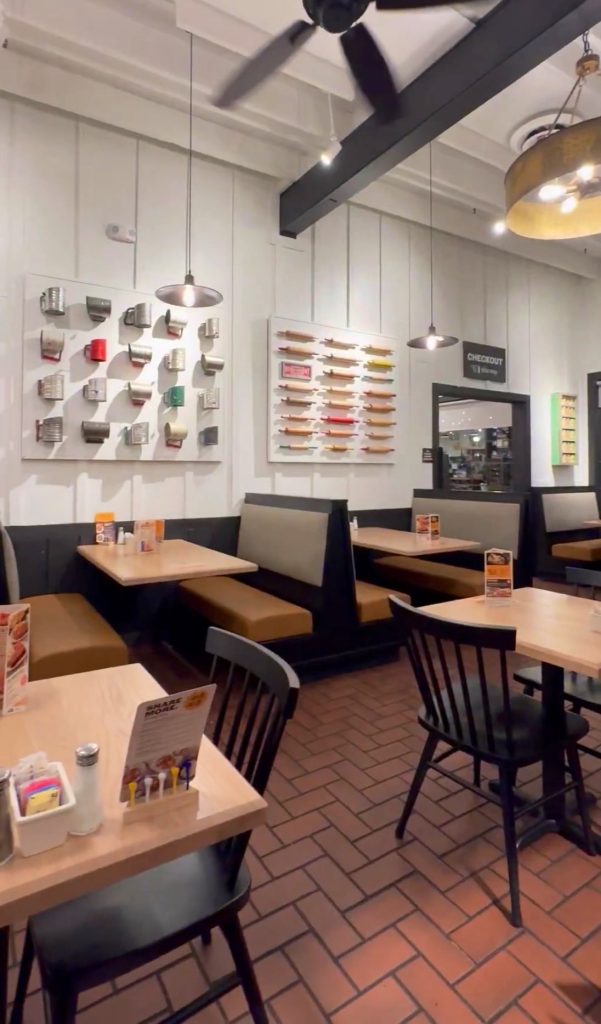
It’s bland. It’s corporate. Clearly they’re going for a brighter, more sterile aesthetic. I’m sure there are business reasons for this. They may be intentionally making the environment LESS comfortable, in order to turn tables faster. Theoretically, the faster you can get customers to eat, pay, and leave, that’s more customers you can seat in a day and therefore make more money.
The trick is to make the environment comfortable enough that people are still willing to come in, but not so comfortable that they stay any longer than absolutely required. While I disagree with it as a business tactic, from the perspective of a big corporation with shareholders — where the goal is to squeeze out a few more pennies per share by any means necessary — it does make a certain logical sense.
From the perspective of being a human being, trying to enjoy life, anything that makes our surroundings less comfortable on purpose, is just a dick move. (In my humble opinion.) While making a profit is critically important — a business cannot survive without profits — maximizing profit is not always the “right” thing in and of itself.
In my own restaurant, I strive to make it as comfortable as possible, so folks want to stay around a long time. My theory is that the longer they stay, the more they are likely to order, which is good from a profit standpoint. Also, a full restaurant almost always looks better to passerbys.
I would have my restaurant be full all the time if I could, even if that meant folks (voluntarily) staying at the same table for hours. During the busy times — like the lunch rush, where tables are genuinely scarce — most people naturally hurry themselves up to make way for others who are waiting. Sure there are occasionally rude, selfish people who hog a table without ordering much and don’t care, but I’m not the karma police. Otherwise, stay as long as you want.
Am I maximizing profit? No. I’m sure I could squeeze a few more pennies of profit here and there by rushing people through, but then I’d have a restaurant that was a little less awesome to go to. It’s a tradeoff, and not everyone may agree with me, but it’s my choice.
But back to rebrands:
What are other bad reasons for rebranding?
I read the Cracker Barrel rebrand as a desperate effort to maximize profits, by out-of-touch corporate execs who don’t understand their customers at all. While obviously I think it’s stupid and will ultimately lead to Cracker Barrel’s demise (but not until after the execs who did it have left the company with multi-million dollar severances), the impulse is quite understandable from a human psychological perspective.
Magical Thinking
Any time things aren’t going well — or as well as we think they should be — the natural reaction almost everyone has is “we need to DO something about this!” In the hurry to DO something, we don’t engage our brains well enough to find the RIGHT thing to do, and instead do the EASY thing that comes to mind.
Understanding your customers is hard. You have to — ugh — actually speak with them! No no, that’s too hard. Making new products or offering new services customers want — that’s too hard as well. How about a new logo? A new website? Perfect! Maybe that will be the magical thing that solves all our problems.
I use the word “magical” here on purpose, as I call this whole exercise engaging in magical thinking. That’s where, instead of doing the hard work to figure out what you really need to do, you randomly grasp at straws until you find the thing that magically works. Not a good business plan.
Listening to Marketing People
Marketing people make money selling you, well, marketing. From their perspective, any problem can be solved with spending lots of money on their services. That could mean a new logo, a new website, and a new marketing campaign to announce it all. Whether the campaign is successful or not, the marketing agency gets paid either way.
Every business is different and the solution for each may be unique, but more often than not it’s the boring, tried-and-true methods that work best. An honest marketing guy may advise you to put a coupon in the local newspaper, or get a billboard along the highway, but he won’t make as much money on these things as he will selling a slick TV ad campaign, or a bottomless-pit digital ad buy.
Speaking of TV ads, there’s something about business owners’ egos that they just love seeing themselves on TV. The thing is, unless you’re a celebrity, nobody cares who you are. Your customers care about your product or service, not you. That’s why I find it hilarious when business owners (especially small business owners) put themselves front-and-center instead of their products. Which leads me to:
Ego, vanity projects, and change for the sake of change
The worst reason to do a rebrand, and yet one that happens so often, is when a new owner or leader of a business comes in and decides to put their personal stamp on the brand… just because. Being blinded by ego it probably feels like the natural thing to do, but it’s just stupid and in many cases counter productive.
If you have an established business, your customers know you by a certain name or logo. Good or bad, it probably took a lot of time and effort to build up that awareness. If your customers have any complaint about you, it’s probably about the quality or price of your product/service. Probably somewhere in the neighborhood of zero people think your problem is your logo.
This reminds me of the downfall of a once great tech company that executed one of the dumbest rebrands ever on their way to irrelevance. In fairness, Yahoo had lots of problems to deal with even before Marissa Mayer took over as CEO in 2012.
In 2008, Microsoft Corp. had made an offer to acquire Yahoo for $47 billion dollars. In what would eventually become one of the stupidest decisions in the history of Silicon Valley, Yahoo rejected this on the grounds that it wasn’t enough money.
Fast forward a few years and a few CEOs later, and Yahoo is locked in a struggle with Google for dominance of the web. In the middle of this Mayer arrives on the scene to find a way to lead the company to victory. She tried a lot of things (and made a lot of stupid moves), but nothing was more emblematic of her tenure than… the rebrand:
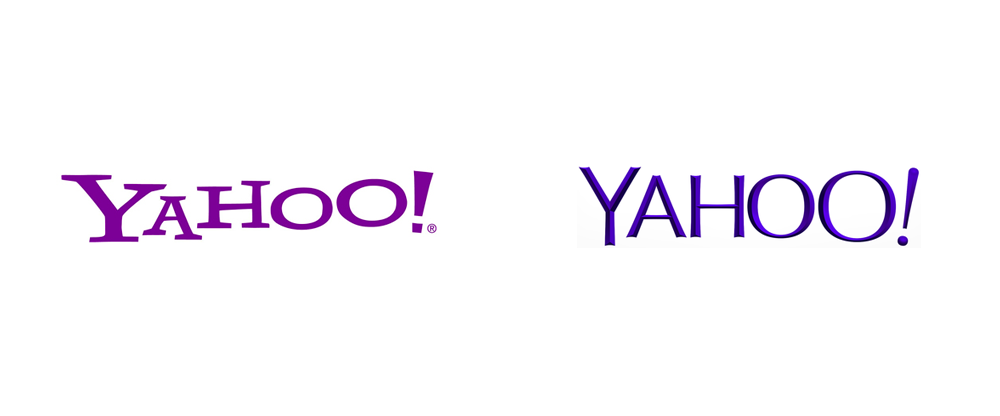
Yup, that was the problem, it was the logo. Who knew?
Those of a certain age who were alive from 2000-ish to 2013 must certainly be familiar with the old Yahoo logo. Like any other huge brand, everybody knew it.
Well clearly what the company needed all along was just a more stylish, more feminine logo font from their CEO. How did it work out? In 2017, Yahoo was sold to Verizon Communications for $4.87 billion dollars, and Mayer “exited” the company with a $23 million dollar severance package. She sold the company for 1/10th what it had been worth prior to her management. Job well done!
Okay, so when is it a good thing to rebrand?
There’s really only one time it makes sense to rebrand, and that’s when the business has a bad reputation it needs to get away from. No business is perfect and when a mistake is made there are lots of things you can potentially do to do damage control. But if there’s enough “bad juju” out there, it may make sense to rebrand. Maybe change the logo, maybe change the name entirely, or maybe change your aesthetic to attract a different clientele than you had before. I view this as a last resort, because getting customers to know about you is one of the biggest challenges in business. Hitting the reset button on that is a big decision, and shouldn’t be made lightly.
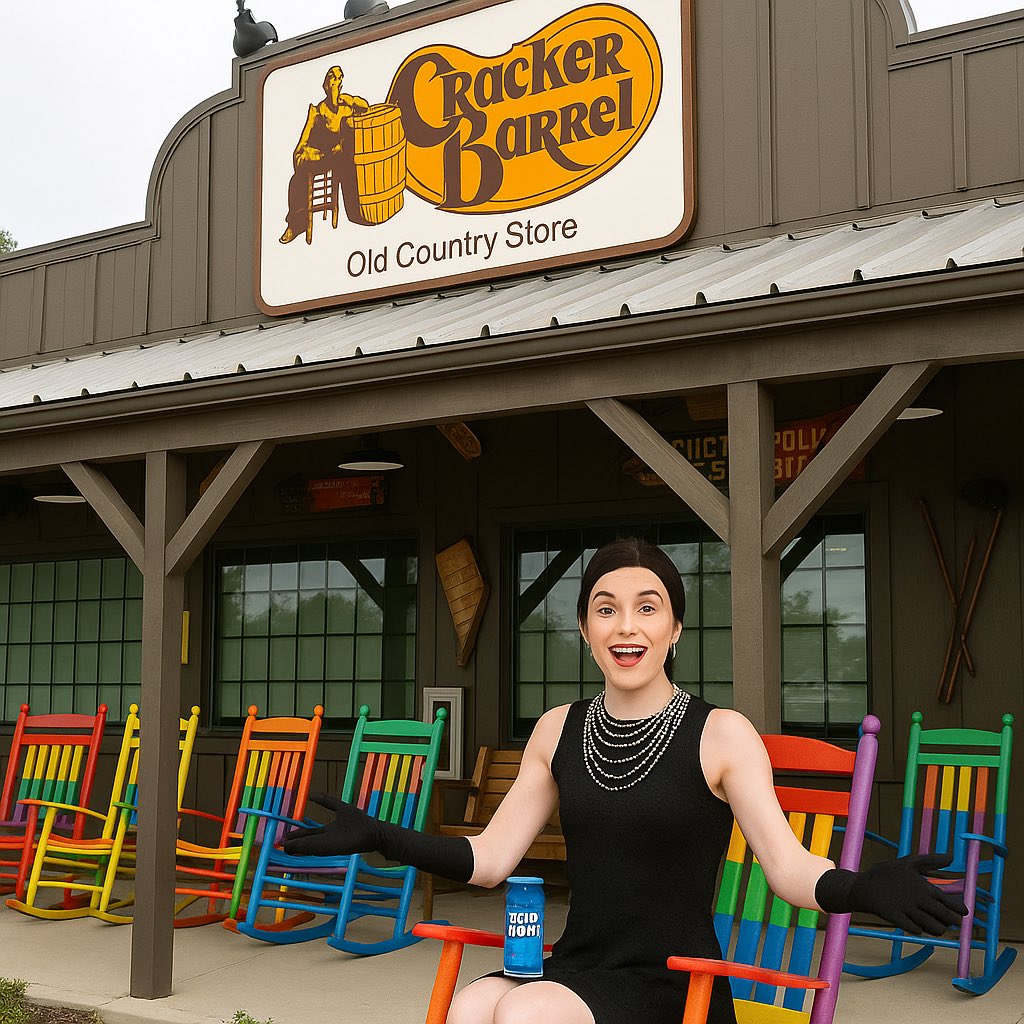
One reply on “When Not to Rebrand: The Last Act of a Desperate Business”
This article nails it. If corporate executives considering a rebranding would read this article, their companies would be a lot better off. I consider myself to be Liberal-leaning and I struggle to see how the new failed Cracker Barrel design was “woke” but I definitely saw it as out-of-touch with the customers. If a franchise corporation wants to rebrand, they should consult with their franchise managers/operators, who actually know the customers and have a better understanding of how to grow business than corporate executives. But there is the problem, just as also explained in this article: corporate executives have inflated egos, think they know better, and are too excited to make their mark and claim their “vision” as impactful.